Alternate picking is the main guitar picking technique. If you play with a pick you should get into the habit of alternate picking early on: a good picking technique will help you to play faster and more fluently.
In this lesson, we start by explaining what alternate picking is. We then provide several alternate picking exercises that you can use to develop your technique.
A special 'bonus' exercise is provided at the end of the lesson – it's a challenging picking study that's good for a bit of 'guitar shop showing off'!
This lesson is part of our How To Get Better At Guitar series.
What Is Alternate Picking?
Alternate picking is playing with alternate up and down strokes of the guitar pick. It is the main guitar picking technique. There are others, but if you play with a plectrum you'll still use alternate picking for the majority of your playing.
To learn about holding a pick and basic picking technique, see this lesson: How To Hold A Guitar Pick & Basic Picking Technique.
Alternate Picking Exercises Notes
It's important that you use strict alternate picking for all of the following exercises.
You're only allowed to try the bonus exercise once you can play all of the other exercises perfectly. Think of it as a reward!
Start at a dead slow tempo and only raise it when you can confidently play the exercise without any errors.
Increase the tempo in gradual increments until you are playing just outside of your comfort zone. Struggle at this tempo a few times, then make a note of the tempo and move on.
In your next practice session start at a slower tempo again, and repeat the process. Within a couple of weeks, you'll find that you've left your original highest tempos behind!
These exercises are suitable for beginners and advanced players. Adjust the starting tempo depending on your level of playing.
Picking Direction Symbols
In order to play the following alternate picking exercises, make sure that you are familiar with picking direction symbols:
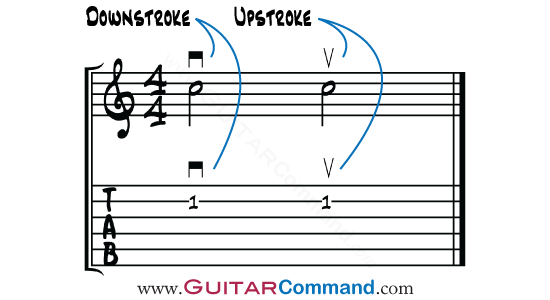
Picking Exercises
Exercise 1
This is a 2 octave C major scale, played up and down. Concentrate on using strict alternate picking, and note where the up and down strokes fall on the start, top and end notes of the scale.
Be sure to use alternate picking throughout the exercise.
For the first three exercises, set your metronome to eighth notes without any accents on the first beat.
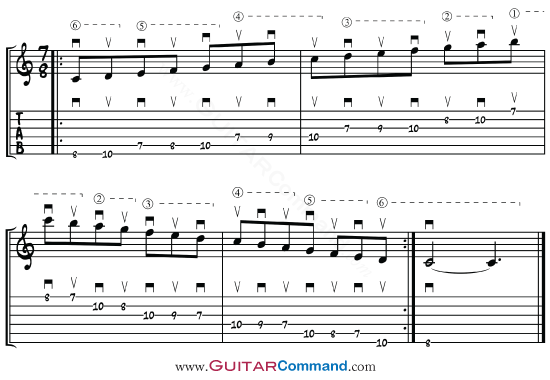
You don't have to play these exercises in C major: try moving them up or down the fretboard to play different scales.
[ad name="Google Adsense Lge Rec"]
Exercise 2
This is just the same as before, but using the opposite picking direction for every note. Again, use strict alternate picking.
Note where the up and down strokes fall. Did you find it easier or harder this way? You may have found if easier coming down the scale than coming up (or vice versa). If so, you could start any descending lines in your regular playing with an upstroke.
Although it's good practice to practice and improve any weaknesses in your playing, when you are playing live or recording there is no harm in taking the easier option.
Exercises such as these help you to locate the strengths and weaknesses in your playing; knowledge that you can use to your advantage.
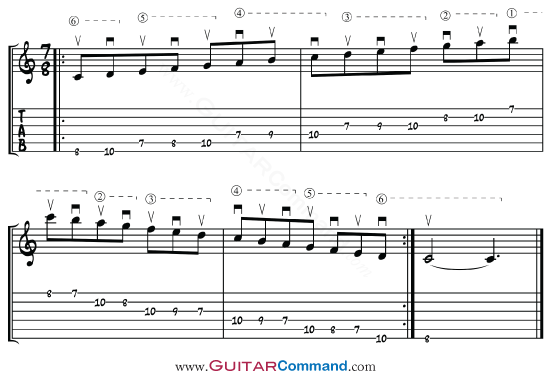
Exercise 3
Now use the 3-note-per-string version of the 2 octave major scale. You may find it easier to play than the standard version. There are many times on the guitar that you can do the same thing in two (or more) ways.

Now repeat the exercise using alternate picking but this time starting with an upstroke.
[ad name="Google Adsense Lge Rec"]
Alternate Picking Exercise 4
Back to the original major scale shape now, and things are about to get a little harder. We're going to play four notes up, jump back two notes, then play four notes up, before jumping back two again, etc. etc.
Follow the notation / tab closely at the top of the scale to keep the exercise flowing.
Set your metronome to play quarter notes for this exercise.
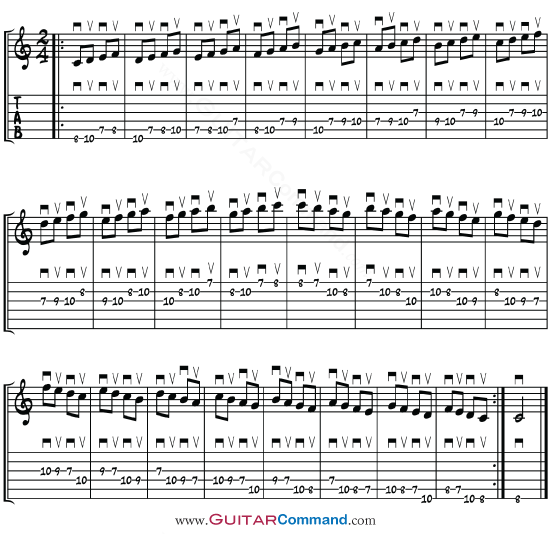
Now repeat the exercise starting with an upstroke.
Exercise 5
The same scale, but with a new pattern. This one moves in triplets: set the metronome to play quarter notes. This exercise can be quite a 'finger-twister' as you are playing the first note of each triplet with a different up/down stroke each time. It's very satisfying to play this one correctly. As with all of the exercises, take it very slowly at first.

Once you've mastered it, start with a downstroke rather than an upstroke.
Exercises 6 - 15
For the next exercises, repeat exercises 1 - 5 but use different scales: first the pentatonic minor scale, then the harmonic minor scale. The basic scales are shown below.
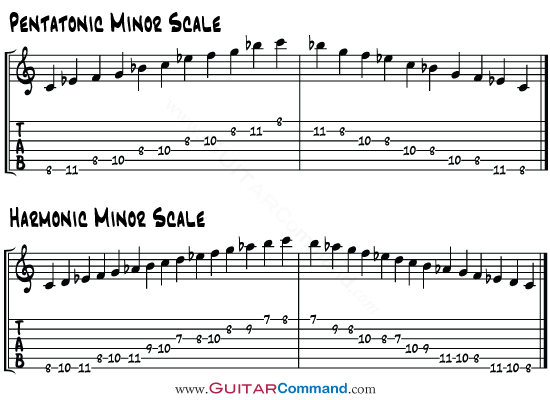
Bonus Exercise / Study PDF
The previous exercises have all been scale-based. This one is a little different because it's based on a 2 octave major 7th arpeggio moved in minor 3rd intervals. Enjoy!
Click to view / download: Alternate Picking Exercise.
Conclusion
I hope that you have enjoyed these alternate picking exercises. You may find them heavy going at first, but be sure to persevere. Having a solid alternate picking technique is a major goal in electric guitar playing.
Subscribe To Guitar Command
Subscribe to our free email newsletter for guitar lessons, news and information.


